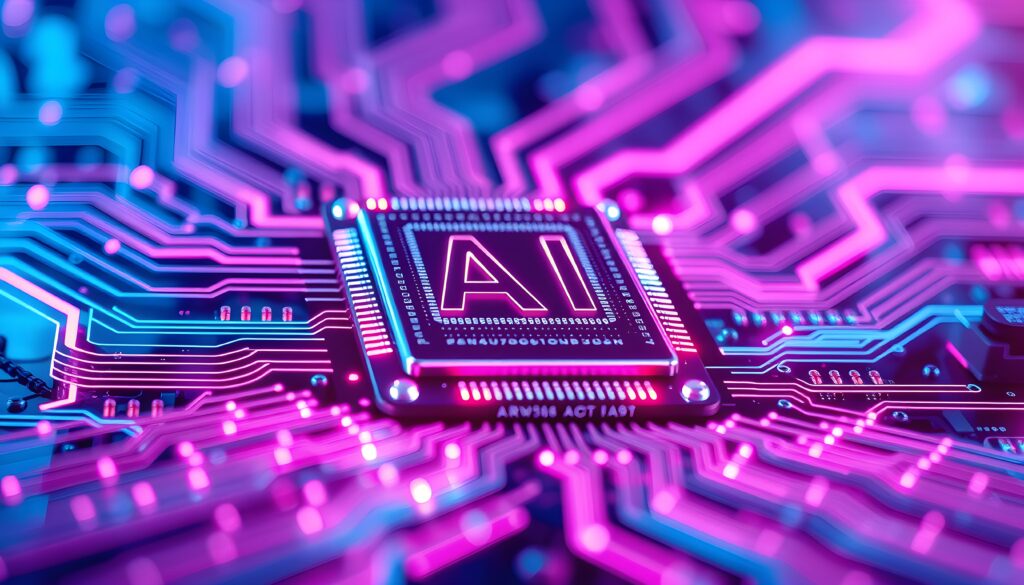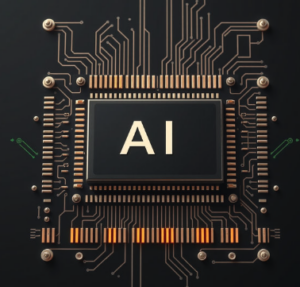
The Growing Need for AI Hardware
Artificial Intelligence (AI) is transforming industries across the globe, revolutionizing fields from healthcare to finance, manufacturing, and beyond. The development of sophisticated AI systems has brought unprecedented challenges in terms of computing power, particularly in the realm of deep learning and machine learning. To manage these tasks, companies are increasingly turning to specialized hardware — the most significant being AI chips, which are designed to handle the complex computations required by modern AI algorithms.
For many years, Nvidia has led the AI chip market with its highly specialized Graphics Processing Units (GPUs). Nvidia’s dominance has been driven by its ability to deliver performance that excels in parallel processing — a necessity for AI workloads that require massive data processing capabilities. However, Amazon, a leader in cloud computing through its AWS (Amazon Web Services) platform, has decided to challenge Nvidia’s reign by investing heavily in custom-designed AI hardware.
The Importance of AI Chips
AI workloads, especially those that involve deep learning, are computationally intensive. Training AI models on traditional processors like CPUs (Central Processing Units) can be inefficient, as CPUs are not optimized for the parallel processing required for AI tasks. GPUs, developed by Nvidia, have become the go-to hardware for training AI models due to their ability to handle large datasets and run multiple tasks simultaneously.
But as AI continues to advance, the demand for more specialized hardware is increasing. Companies like Amazon recognize that custom-built AI chips can offer better performance, scalability, and efficiency compared to general-purpose GPUs. By designing its own AI chips, Amazon can optimize its hardware to better integrate with its cloud infrastructure, providing customers with an even more powerful and cost-effective solution.
Amazon’s Move Into AI Hardware Development
Amazon’s push into AI chip development began in earnest after it acquired Annapurna Labs in 2015, an Israeli-based semiconductor company. This acquisition marked the beginning of Amazon’s strategic move to design custom chips tailored to its specific needs, particularly for its cloud services division, AWS. Annapurna Labs was known for its expertise in semiconductor design, and the acquisition allowed Amazon to build upon this expertise to develop custom chips for a variety of applications.
In the years following the acquisition, Amazon rolled out several AI chips, starting with Inferentia and Trainium. These chips were designed to accelerate machine learning workloads, with Inferentia focused on inference tasks and Trainium optimized for training deep learning models. These two chips marked the first significant step in Amazon’s efforts to reduce its reliance on third-party hardware vendors like Nvidia and to take control of its AI hardware ecosystem.
Inferentia: Amazon’s First AI Chip
Inferentia was Amazon’s first foray into AI chip design. This custom chip was created with the aim of accelerating machine learning inference tasks. Inference refers to the process of using a trained AI model to make predictions or decisions based on new data. For example, in Amazon’s case, this could involve product recommendations, fraud detection, or language translation.
Inferentia was designed to deliver superior performance compared to traditional CPUs and GPUs, while also being more cost-effective. Its architecture was specifically optimized for AI inference workloads, with a focus on achieving high throughput with low latency. Inferentia quickly gained traction within AWS, helping to power a wide variety of machine learning applications. The chip’s ability to perform real-time inference at scale made it a compelling option for customers looking to deploy AI solutions in the cloud.
Trainium: Amazon’s AI Training Chip
Following the success of Inferentia, Amazon introduced Trainium, a custom chip specifically designed to accelerate the training of deep learning models. Training AI models is a highly resource-intensive task, requiring vast amounts of computational power and energy. As AI models grow in complexity, the need for specialized hardware becomes even more critical. Trainium was developed to address these challenges, offering improved performance over traditional GPUs and greater energy efficiency.
Unlike Inferentia, which was optimized for inference, Trainium is built to handle the intensive training workloads that involve massive datasets and require significant processing power. Trainium’s architecture is focused on optimizing the training of large-scale models, making it particularly well-suited for AI research and development. The chip has been able to achieve significant performance improvements over Nvidia’s GPUs, particularly in cloud environments.
Trainium has been integrated into AWS, allowing Amazon’s cloud customers to train AI models more efficiently. By offering customers access to Trainium-powered instances, Amazon is positioning itself as a strong competitor to Nvidia in the AI hardware space.
Trainium 2: Amazon’s Next-Generation AI Chip
In late 2024, Amazon unveiled Trainium 2, the next generation of its AI training chips. Trainium 2 builds upon the foundation of the original Trainium chip but introduces several advancements aimed at improving performance, efficiency, and scalability.
One of the key features of Trainium 2 is its energy efficiency. As AI training becomes increasingly resource-hungry, energy consumption is becoming a major concern in the AI community. Trainium 2 is designed to deliver high performance while minimizing power usage, making it an attractive option for customers who need to train large AI models but are concerned about the environmental impact of their operations.
Trainium 2 is also optimized for scalability, enabling customers to scale their AI training workloads more easily. With the ability to handle larger models and more complex datasets, Trainium 2 positions Amazon as a serious contender in the AI hardware market. Early tests have shown that Trainium 2 outperforms Nvidia’s A100 and H100 GPUs in certain AI training tasks, particularly in cloud environments where Amazon’s infrastructure can maximize its potential.
The Competitive Landscape: Amazon vs. Nvidia
Nvidia has been the undisputed leader in AI hardware for years, with its GPUs being the preferred choice for AI researchers, developers, and businesses. The company’s CUDA software framework has become the standard for building and running AI models, creating a strong network effect that has made it difficult for competitors to challenge its dominance.
However, Amazon’s entry into the AI hardware market with its custom chips has the potential to disrupt Nvidia’s position. Amazon’s strategy is not just to compete on raw performance but also to offer a more tailored solution for its cloud customers. By integrating its custom chips into the AWS ecosystem, Amazon is providing an optimized platform for training and deploying AI models.
Nvidia, for its part, continues to innovate with its GPUs. The company recently introduced the H2000 series, a new line of GPUs designed to handle the growing demands of AI workloads. However, Amazon’s focus on creating energy-efficient, cost-effective chips gives it a unique edge in the cloud market, where customers are increasingly looking for scalable, affordable AI solutions.
Project Rainier: Amazon’s AI Data Center Initiative
To further solidify its position in the AI hardware market, Amazon is also investing in the development of massive AI data centers through Project Rainier. These data centers are designed to provide the infrastructure necessary to train and deploy AI models at scale. By building its own AI-focused data centers, Amazon is positioning itself to offer a fully integrated solution that combines AI hardware, cloud services, and software.
Project Rainier represents a long-term strategic investment for Amazon. By creating dedicated AI data centers, Amazon can provide its customers with the infrastructure they need to scale their AI workloads more effectively. These data centers will also be optimized for Amazon’s custom AI chips, such as Trainium 2, making them a powerful solution for companies that need to perform large-scale AI training and inference.
Challenges and Opportunities in the AI Hardware Market
The AI hardware market is still in its early stages, and companies like Amazon face several challenges as they compete with established players like Nvidia. Developing AI chips is an expensive and complex process, requiring substantial investment in research and development. Moreover, AI hardware development requires more than just cutting-edge hardware; it also requires a robust software ecosystem that can support these chips and make them accessible to developers.
However, the opportunities in the AI hardware space are vast. The demand for AI hardware is expected to grow exponentially in the coming years as more industries adopt AI technologies. Companies that can provide efficient, cost-effective AI solutions will be well-positioned to capitalize on this demand. Amazon’s strategy of building custom AI chips and data centers places it in a strong position to become a dominant player in the AI hardware market.
Amazon’s Future in AI Hardware
Amazon’s decision to invest in developing its own AI chips is a bold move that has the potential to reshape the landscape of the AI hardware industry. With chips like Inferentia, Trainium, and Trainium 2, Amazon is positioning itself as a strong competitor to Nvidia in the cloud-based AI hardware market. By creating custom chips that are optimized for AWS, Amazon can offer its customers a more cost-effective and scalable solution for their AI needs.
While Nvidia remains the leader in the AI hardware space, Amazon’s push into AI chip development represents a significant shift in the market. As the demand for AI continues to grow, companies like Amazon that focus on building specialized hardware tailored to their cloud infrastructure will be well-positioned to lead the way in the future of AI technology.
Visit our other website: https://synergypublish.com



